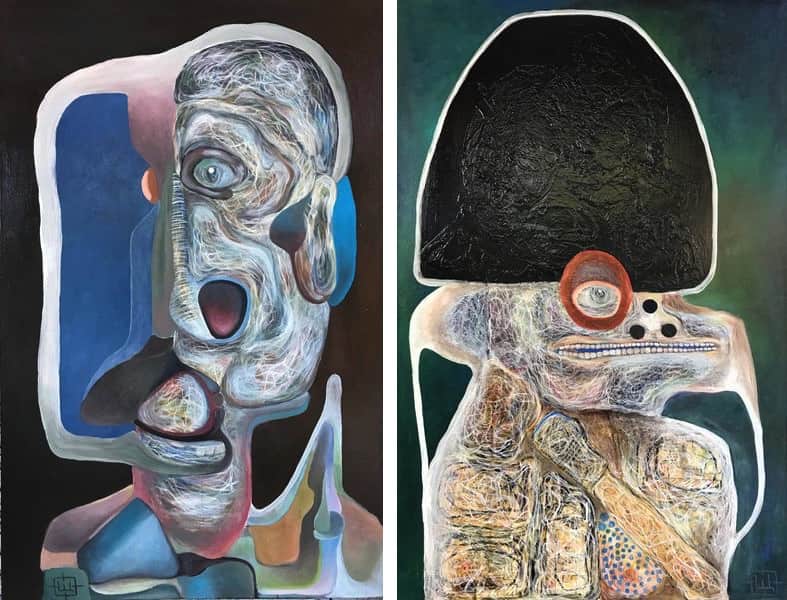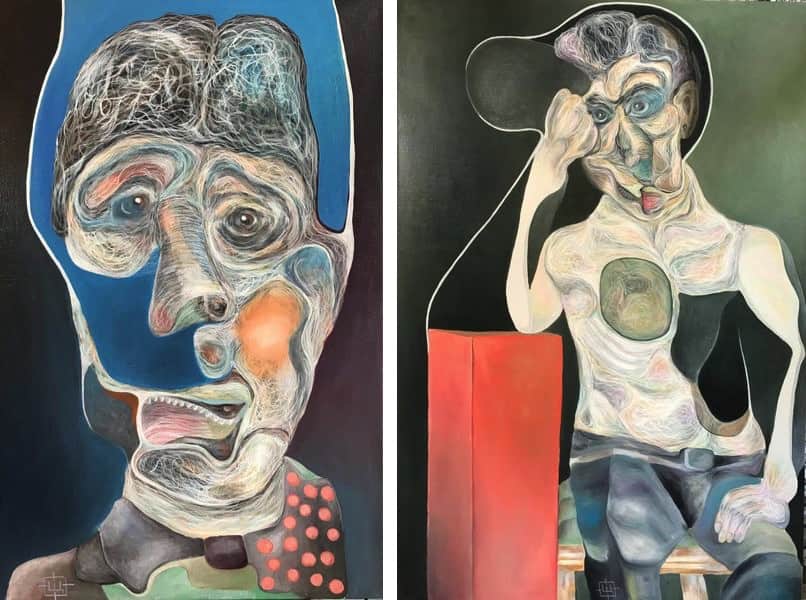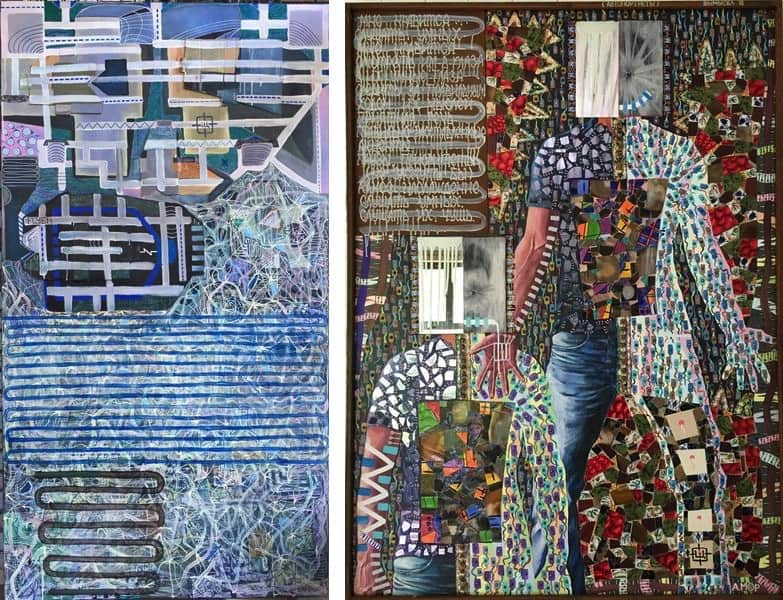[ad_1]
Living and working in Ukraine, the painter Sergey Morshch has a unique vision and style. Challenging the very idea of who we are, what “wholeness” means and how the universe manifests itself, he established a new visual language, creating portraits that are fluid, luminous and charged.
In his practice, Sergey combines science, spirituality, poetry and art in a unique and eclectic way. The notion that the whole Universe is not limited to physical bodies and objects is at the core of his practice. With a background in Physics, he is interested in the laws of the Universe, guided by the desire to get to the bottom of the truth. The idea closest to his heart, which also informs his art practice, is that energy looks like an accumulation of luminous filaments or fibers which connect everyone and everything in the Universe.
The work of Sergey Morshch is process-oriented, allowing the form to appear spontaneously and becomes filled with luminous filaments. Through his creative process, he gets to know not only the world of art, but himself as well.
We had a chat with the artist to find more about his practice. In an exclusive Widewalls interview, we talk about his background in science, the wholeness of the Universe, spirituality, his creative process, and much more.

The Wholeness of the Universe as an Inspiration
Widewalls: You are a trained Physics Engineer. How did this background influence your art practice?
Sergey Morshch: That’s correct, there is some influence. And in fact, this influence affects everybody who deals with science. I’m talking about the strong desire to get deeper to the core, to the truth of the matter. And to do that, one needs a sense of curiosity, thoughtfulness, ability to analyze and most critically – an ability to concentrate the attention on the main goal.
This is only to start the creative process. As soon as it begins, there are other laws, outside of the physical plane, driving it.
Widewalls: Your art deals with the idea of the wholeness of the Universe. Could you tell us something about your artistic approach and vision? What are the thoughts and emotions you hope to provoke with your work?
SM: In my vision, we are energy creatures and to think otherwise, even contradicts the modern science. I think no one has a doubt that we are not merely another type of conscious matter. Same as the Universe, which is not only Universe of physical bodies but also Universe of energies.
Spiritual traditions, as well as scientists including Stephen Hawking who supported “a string theory”, share an opinion that the energy itself looks like an accumulation of luminous strings or filaments, which connect everything in this Universe. The light of these filaments fills up this world with waves of love and passion, creating a space for this magnificent reality.
The reality that motivates us to seek, research and develop and be the best version of ourselves at every moment.
With regards to feelings and emotions, my paintings provoke – I don’t have an answer. However, I’d like to quote a few lines from the poem by Juan Ramon Jimenez:
…anticipation of an unknown happiness;
…and a long second of wonder.
…The entire moment we reign over our own lives!
Widewalls: How do you see the place of a man in this interconnected reality?
SM: I think a man holds the same place in the universe as any other living creature. Not more and not less. I think in this entire infinity, we are all equal.
The fact that a man puts himself on a pedestal, including the top of a food chain, doesn’t mean anything. For worms, for example, we are the same as sandwiches, hot-dogs, beef steaks or a caramel ice-cream.

Art and Spirituality
Widewalls: The spirituality is an important part of your practice. Which spiritual traditions have informed your work the most?
SM: I would like to avoid relating to any specific spiritual tradition because oftentimes spiritual tradition is not a “pure knowledge” itself. Instead, it is someone’s interpretation of this knowledge which can be misleading. I think that a similar situation takes place in science, the art world, religion and any other part of our lives.
Wrong interpretations, often stimulated by commercial interests, take us further away from the truthful knowledge. So I believe that in order to get closer to the truth, we, first of all, need common sense, the ability to analyze and activism.
And also, to be vigilant to someone’s interpretations, because there are always specific people and interests behind them.
As for spirituality, I think it is about being honest to ourselves. It is easy to be honest to people, surrounding us, but try to be really honest with yourself! “Why do I need someone’s ideas or interpretations if they only make me struggle?”
Widewalls: Your paintings are the result of the free movement of meanings and the flow of associative connections. Could you tell us something about your creative process?
SM: For me, the process of creation is above the concept. When I have some ideas, they only help me to start working. And even when I have a clear image in my head, still at the end, the outcome doesn’t look similar to my initial idea. Therefore the final result is always intriguing and unpredictable.
It’s almost like having a baby when you desperately wait for his arrival just to see how much he looks like his father. But in my case, the dads are always different, I guess.
During the creative process, I try, as much as I can, not to think about anything at all and not to imagine anything. It may sound weird, but I feel that during the process of creation, I’m “in the game”. And when I finish, I have to “quit the game” and I lose access to it until the process starts again. And in this way, step by step, something materializes with its own shape, character and its own life. And this life, as the result, gets filled with luminous filaments, which from my point of view creates and explains the meaning of everything. Even the process is driven by the same filaments, I’m sure about it. That’s why diving into this process allows me to have a mysterious experience which is hard to achieve otherwise. Perhaps, it is also one of the reasons why people are attracted to arts so much because this mystical experience is available not only for creators but also for art viewers.
Once, I witnessed this active connection – at one of my shows, a visitor was studying one of my works in details. And suddenly, she felt down and passed out. When later people asked her what happened, she said it was caused by overwhelming emotions. Later, she came to the gallery several times and enjoyed the same work while art reps were constantly alerted, worried that she can fall again and injure herself.

Future Plans and Projects
Widewalls: Which artists have inspired your vision and whose work do you appreciate now?
SM: At different times I was inspired by different artists. If we talk about this specific moment (June 17th 2018, 3.45pm), now I’m admiring works by Richard Prince and Robert Rauschenberg.
When we talk about the appreciation of artworks, I think that subjectivity has a minor role comparing to the time: what at this moment of time is needed for society, where is its focus at? If someone cuts a shark into pieces and it is appreciated by society – it means that the artist has a great power to feel that societal need in this action. Perhaps, later someone will cut himself in halves and will be appreciated as well.
Widewalls: Where can the audience find your work?
SM: Although I’m not a very active user of social networks, I still display all my works via Facebook.
At this point, my own website is not the best solution for me as it lacks dynamism. At least, I don’t feel it. Facebook provides this dynamic as well as a feedback.
Also, my works are represented at several galleries, including Art Acacia Gallery, which facilitates this dialog.
Widewalls: Could you reveal some of your future plans and projects?
SM: I have several projects at the moment. One of them is a series of portraits which are called Luminous. The other one connects to an opposite aspect of my creativity, which are called Crucifix. I have a lot of them, although at the first glance it seems like they don’t relate to the subject. Well, that is how I see it. The central place in this project belongs to the actual crucifix with a text over it “How are you?”.
And also, when it comes to plans, I’d like to mention a quote from Pablo Picasso:
Good artists copy, and great artists steal.
So if we have no other alternative, I plan to become a thief.
Featured image: Sergey Morshch – Luminous near the red pedestal (detail), 2017; Sergey Morshch – Luminous 69, 2016. All images courtesy of the artist and Art Acacia Gallery.
[ad_2]
Source link
